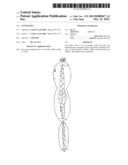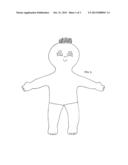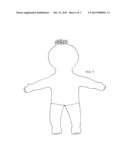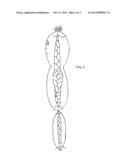Patent application title: Nettie Doll
Inventors:
Carolyn Louise Blue (Algona, WA, US)
IPC8 Class: AA63H302FI
USPC Class:
446369
Class name: Amusement devices: toys figure toy or accessory therefor fabric-covered stuffed figure
Publication date: 2013-10-31
Patent application number: 20130288567
Abstract:
The Nettie Doll is an eco-friendly cloth doll with out-stretched arms,
designed to greet, hug and love children of all ages, is made entirely of
fabrics, fibers and threads that are organic, sustainable and/or
renewable.Claims:
1. The invention is the Nettie Doll
2. The Nettie Doll pattern is a unique design with out-stretched arms as if to greet and hug.
3. The Nettie Doll is made entirely of fabrics, fibers and threads that are labeled and sold as organic, sustainable and/or renewable.
Description:
CROSS-REFERENCE TO RELATED APPLICATIONS
[0001] Not Applicable
STATEMENT REGARDING FEDERALLY SPONSORED RESEARCH OR DEVELOPMENT
[0002] Not Applicable
THE NAMES OF THE PARTIES TO A JOINT RESEARCH AGREEMENT
[0003] Not Applicable
REFERENCE TO A "SEQUENCE LISTING"
[0004] Not Applicable
BACKGROUND OF THE INVENTION
[0005] This invention pertains to handcrafted cloth dolls and the materials that make up all features of the cloth doll. The Nettie Doll presents a new way to fashion a cloth doll and is created without synthetic fabrics, fibers and threads by using organic, sustainable and/or renewable fabrics, fibers and threads; these materials reduce a child's exposure to potentially toxic chemicals.
[0006] Dolls can be made out of almost anything. Some of the earliest dolls were fashioned from perishable materials such as wood and fur or cloth, as well as more long-lasting clay or stone.1 Cloth dolls date back to many hundreds of years ago made as toys for children. A cloth figure, traditionally home-made or handmade, was crafted from readily available material. Fabrics have changed through the ages including, but not limited to, synthetic fibers, or filaments and substances, made from chemicals. Today, many dolls are made from synthetic fabrics, fibers and threads. 1. Encyclopedia Britannica--Cloth doll
[0007] Synthetic fabrics are textiles made from synthetic fibers. They are used primarily to make clothing. A synthetic fabric is plastic fabric. Some of the examples of synthetic clothing were usually made of polyester, acrylic and nylon. A synthetic fiber, when magnified, looks like plastic spun together. Man-made fabrics, also known as synthetic fabrics include fabrics such as rayon, acetate, nylon, acrylic, polyester, olefin, spandex, Lastex and Kevlar. These fabrics have many different uses and qualities, some which cannot be achieved with natural fibers. With synthetic fibers one can create waterproof fabrics and fabrics with an excellent amount of stretch used for swimwear and lingerie. The fabric is made from chemically produced fibers. The chemicals used to make the fibers are sodium hydroxide and carbon disulphide which are derived from coal, oil, or natural gas. The chemicals are in liquid form and are forced through tiny holes called spinnerets. As the liquid comes out of the spinnerets and into the air, it cools and forms into tiny threads. Dyes are added to these threads before they are woven together to make the fabric. Depending on the fabric, other chemicals are added to make the fabric softer, wrinkle free, flame-resistant, water resistant, stain-resistant, and moth-repellant. While all these qualities are desirable, they can have harmful effects on the environment, wildlife and our health, especially for those who work to produce the fabrics. The chemicals leach out into the waterways, airways and pollute the ground, water and even the air we breathe. Also these fabrics are non-biodegradable, which means they do not breakdown in the soil.2 2. Wikipedia--Synthetic fabric
BRIEF SUMMARY OF THE INVENTION
[0008] The Nettie Doll is a soft, cuddly, lovable, handcrafted cloth baby doll; it is a humanoid form with a head, neck, torso, appendages (arms and legs), and digits (fingers, thumbs, and toes) and is not gender specific. It is made entirely of fabrics, fibers and threads that are labeled and sold as organic, sustainable, and/or renewable. Accordingly, it is stuffed with a soft batting to establish its features and shape.
BRIEF DESCRIPTION OF THE SEVERAL VIEWS OF THE DRAWING
[0009] FIG. 1 illustrates the front view of the Nettie Doll. The out-stretched arms, designed to greet, hug and love children of all ages. The embroidered facial features include two eyes with lashes and eye brows, a nose and mouth; the head is crowned with a tuft of silk or hemp fiber for hair.
[0010] FIG. 2 illustrates the back view of the Nettie Doll. The out-stretched arms, the head crowned with a tuft of silk or hemp fiber for hair.
[0011] FIG. 3 illustrates the cross section of the left side of the Nettie Doll with the side seam open and left arm removed. The soft batting shown within the open seam establishes its features and shape. The batting along with the outer fabric, sewing thread, embroidery thread, silk and hemp are all organic, sustainable and/or renewable fabrics, fibers, and threads that make up the Nettie Doll.
DETAILED DESCRIPTION OF THE INVENTION
[0012] The invention is the Nettie Doll.
[0013] The Nettie Doll is a soft, cuddly, lovable, handcrafted cloth baby doll; it is a humanoid form with a head, neck, torso, appendages (arms and legs), and digits (fingers, thumbs, and toes) and is not gender specific. It is made entirely of fabrics, fibers and threads that are labeled and sold as organic, sustainable, and/or renewable. Accordingly, it is stuffed with a soft batting to establish its features and shape.
[0014] Because of the nature of handcrafted products, slight variations in shape and dimension may occur, so the approximate overall length is 14.5''; the head is a roundish shape with a width of 4.5''. The neck measures 7.0'' in circumference. The length of the torso is 5.25'' and its width is 4.0''. The out-stretched arms, designed to greet, hug and love children of all ages, spans 12.0'' measured across the back, fingertip to fingertip. Each leg, measured from the end of the torso, terminates with a nondescript foot that is 5.0'' long with five toes. Each arm terminates with a hand, four distinct fingers and a thumb. The embroidered facial features include two eyes with lashes and eye brows, a nose and mouth; the head is crowned with a tuft of silk or hemp fiber for hair.
[0015] Intended for use by humans between the ages of 3 and 103, it is a toy cloth doll that is very soft and cuddly to hold and hug; it can be played with and dressed with designer clothing.
[0016] The Process:
[0017] The Nettie Doll pattern is one full piece.
[0018] Using a soft organic fleece, position the fabric with right sides together indicating a double thickness, place the pattern on the straight grain of the fabric with arrow parallel to selvage.
[0019] Cut out pattern. Transfer markings to wrong side of fabric.
[0020] Lay doll front on a firm surface right side up. Using the specially designed face-stamp inked slightly, stamp fabric 1.5'' from top of head.
Embroider by Hand the Face:
[0020]
[0021] Use one strand of organic cotton embroidery thread.
[0022] Work outline of eyes, eye lashes, eye brows and nose with outline stitch in a dark color.
[0023] Use two strands of organic cotton embroidery thread.
[0024] Work outline of mouth with outline stitch in pink or red; work center of eyes with a satin stitch in brown, blue or green.
[0025] Using organic cotton thread, machine-stitch the tuft of hair to the doll front on wrong side, 1/4'' from raw edge at center, leaving remainder of tuft sticking up out of the top of head. With right sides together, machine-stitch the doll front to the doll back with 1/2'' seam allowance, leaving left side open between markings for stuffing. Clip neck curves and inner leg seam to stitch line. Turn right side out.
[0026] Cut four pieces of batting 4''×4'' and stuff one piece into each arm and each leg pushing firmly to the end.
[0027] Forming the Fingers and Toes:
[0028] Use two strands of organic cotton embroidery thread.
Fingers Step One:
[0029] Insert needle into hand front (approximately 1/4'' from the end of hand and 1/4'' from the side opposite thumb) working through to back of hand, then looping thread over the end of hand and returning to the front, inserting the needle into where it started. Repeat three times to secure the little finger, finishing with needle at hand front.
Fingers Step Two:
[0030] Insert needle into hand front through the first layer of fabric, this time working toward the next finger, coming up 1/4'' from first stitching keeping it 1/4'' from end of hand. Repeat step one. When the second finger is secure, repeat steps one and two for the third finger, working to form all fingers in this manner, ending with a secure knot.
[0031] Form the toes in the same manner as the fingers starting 3/8'' from the inside leg seam and 1/4'' from end of leg for the big toe, inserting needle front to back and looping over the end, repeating three times. Work across toward the outside seam, spacing stitching 1/4'' apart and 1/4'' from the end of leg, forming each toe and ending with a secure knot.
[0032] Forming Wrists and Ankles:
[0033] To form wrist, measure from end of fingers 1.5'' on under-arm seam, work needle straight through to upper-arm seam about 1/2'' from the thumb. Work needle from seam to seam, catching a small amount of fabric each time on each seam, pulling thread snug as you go. Finish at under-arm seam with a secure knot.
[0034] To form ankle, measure from end of toes 1.0'' on inside leg seam. Work needle from seam to seam, catching a small amount of fabric each time on each seam, pulling thread snug as you go. Finish at outer seam with a secure knot.
[0035] Cut five strips of batting 4''×30''; stuff doll body, beginning at the head, filling arms, legs, and remaining part of torso to complete each feature.
[0036] To allow for an upright sitting position, machine-stitch across the legs from crotch to outer seam.
[0037] To finish the Nettie Doll, close the left side opening with a machine-stitch.
User Contributions:
Comment about this patent or add new information about this topic:




